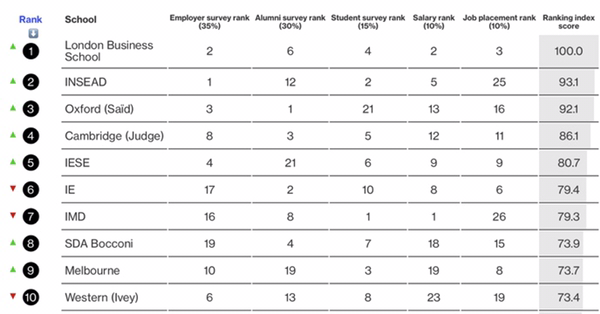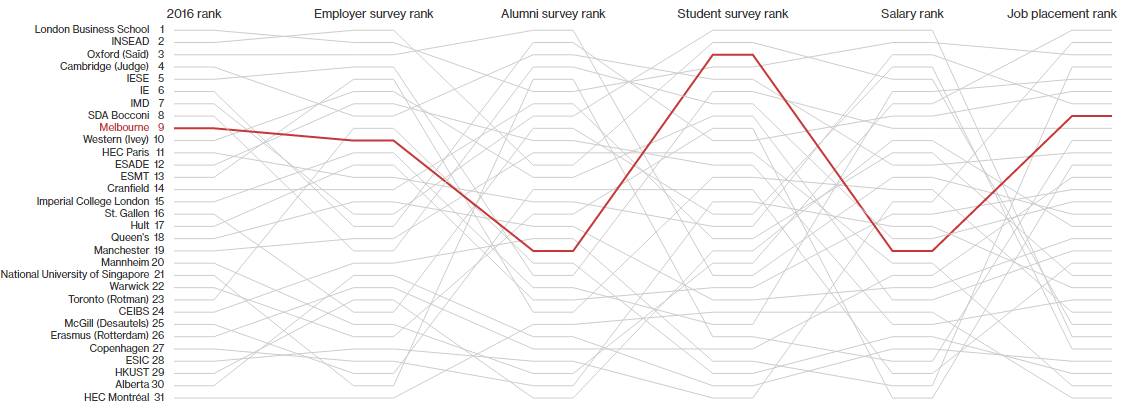In the latest edition of Bloomberg Businessweek, published 4 December 2016, Melbourne Business School (MBS) has made the Top 10 list of International Business Schools.

Adjunct Professor Mark Ritson, who I had the privilege of being taught by for Brand Management, has already highlighted in his reporting, this accolade is significant for various reasons. I share the following thoughts as part of celebrating this wonderful achievement as one of the 1000s of Alumni. As a member of the MBS class of 2010, I may have contributed, in a small way, to the Alumni Survey component of this Bloomberg study…
International Network
Over the years, MBS has participated in international student exchange programs, and this has enabled top students from top business schools to experience MBS. When I was studying at MBS over the period of 2010-2013, my experience as a local part-time student was indeed enriched by the contact and friendships developed with those international students. Even then as students we would discuss and compare the student experience between business schools; some of the cultural and environmental factors we take for granted here were hailed as attractive characteristics for those visiting from overseas. This included teaching and learning methods whereby the MBS culture of intellectual discussion and debate. The MBS emphasis on syndicate/group learning taps into part of the Australian openness to education, and is not readily prevalent throughout the hallowed halls of Top business schools.
Indeed, it has been said that once you get into a business school like Harvard, you join up to a thousand fellow students in lecture-style classes. Just the sheer number of students in that learning environment would prevent class debates and discussion.
The Harvard benchmark is an interesting measure. Whilst on the one hand their teaching mode may require structure conducive to massive class sizes, the research and publications by Harvard are clearly world and top class. Schools like MBS recognise this reputation inherently because a lot of our reading material is sourced from Harvard Business School. In addition to our prescribed textbooks, weekly lists of case studies formed our learning material. These lists of case studies probably comprised at least 40% from HBS.
Ranking Methodology
Behind every ranking is a method and weighting for the various factors that determine the results. Over the years, having discussed ranking of business schools between friends who attend or attended competitor business schools, I have always focused our attention on this important determining factor. Once a friend cited a ranking where Melbourne Business School was absent from the ranking of top Australian business schools. Sometimes, we do need to appreciate the variables that are taken into consideration for determining list eligibility. In that example, I suspect the focus was on business schools who offered online teaching/learning, which is simply something MBS does not do. In the main ranking systems, research is often a key component which is why the University of Melbourne tends to compete with the Australian National University for the number one rank in Australia – both universities receive the most funding for research consistently.
In the Bloomberg ranking, the chart shows it is really an aggregation of multiple surveys where the views of employers, alumni and students have all been sought. Salary and job placement round out the Bloomberg study. The high 35% weighting for employers is interesting given locally in Australia, the industry culture in recruitment is fairly neutral when considering business school backgrounds, let alone university for undergraduate qualifications. Overseas in the UK and US their cultural disposition and relative favouritism towards business schools is more pronounced. The high profile reputation of the likes of Harvard, Wharton or Stanford in the form of Ivy League business schools is clear, and has probably created virtuous cycles of success. Coupled with generous research endowments, it is no wonder the US Ivy League remains entrenched at the top consistently for the last several decades. Have a read of the transparent explanation provided by Bloomberg in their article – the methodology is quite sound and more importantly hard to create out-liers. With a change in emphasis to focusing on “how well the programs prepare their graduates for job success”, the ranking offers a level of practical purpose, informing prospective students to life after studying an MBA. In order for students views to be meaningful, a minimum of 30 students needed to respond, with larger programs having a higher percentage-based threshold. Previous year surveying (25% of the data) also addresses the time-factor influencing data results.
The final but really important point is made at the end of the Bloomberg article and explanation of the rankings – the focus here is on full-time MBA programs. Melbourne Business School designed the full-time program in 2013 at the conclusion of my own part-time study experience. It was a fairly significant redesign which one of my friends experienced first-hand as part of the inaugural cohort. Across the board, in 2013-2014, Melbourne Business School revamped their programs to shorten them and the full-time program became a one-year intensive undertaking (previously it was 18 months). Between the two programs, MBS has historically had a fairly balanced approach, but it is clear that in recent years, greater attention and effort has been focused on improving the full-time program, which has indirectly also enhanced the part-time experience. From my own experience, I would say full-time students spend more time on campus than part-time students by a factor of 3~5. Having served on the Student Representative Council (SRC) for two years helped to increase my contact and interaction with the full-time cohort, and this in itself was invaluable long-term networking.
The final comment in analysing this ranking is that the overarching approach of Bloomberg has been to separate the best US business schools from the top International business schools, which is why, Melbourne Business School can claim a Top 10 ranking within the International rankings, excluding the US business schools. Even a simple attempt to merge the two rankings is not possible since the ranking index score is an internal metric, calculated for each school based on its position on the list. Therefore, both top business schools – London Business School (LBS) internationally, and Harvard domestically within the US – in the premiere position gain an index score of 100.0.
Insights & Analysis
The gap in index score between the top and subsequent positions is interesting. Whereas the US ranking has Harvard as a clear winner, the 10-point gap suggests it is a clear stand-out performer, whereas the 7-point index score gap between LBS and INSEAD shows a tighter competition and closer reputations in the eyes of employers, alumni and students. If Bloomberg completes their rankings publications with a combined list, then we will gain a better appreciation for the true holistic ranking of all business schools, MBS included.
As Professor Ritson rightly discerns, MBS can rightly claim this successful outcome in that MBS is the top regional business school across Asia-Pacific. The next Asian/regional business school is #21 in the National University of Singapore. Interestingly, I suspect their ranking is more a reflection of their contextual reputation; it is not a worthy conclusion to form that NUS is lacking other than to say that the local reputation of NUS and its own brand value-add in the mindsets of local Singaporean businesses, employers, and their own students/alumni will take time to develop. Other extenuating factors like the heavy and high proportion of the Singaporean economy being related to the Singaporean Government could mean that the top students end up working for the government, which is a truism. The employment prospects for top students in Singapore generally is skewed towards the government whereas in other countries, government is probably one of the less likely destinations for a business school graduate.

MBS strength in this recent ranking and survey is its students. The Alumni and salary results are the areas for most improvement, and fortunately, those metrics can be addressed in time. Job placement outcomes are respectable as are the employer survey results. Both these factors, including the salary ranking is highly influenced and subject to external macro-economic forces. Australia’s relative economic stablility and jobs market is a contributing factor to this success. That MBS has risen 14 spots from the 2015 rank of #23 is indeed a reflection of the hard work all sections of the MBS community have worked to deliver on over the last ~five years. With Zeger Degraeve serving as Dean of the school since 2011, it is note-worthy that he previously served the premiere LBS institution over an illustrious 12-year period. If the success and recognition of Zeger’s time at LBS is any measure to go by, only more accolades can come the way of Melbourne Business School!
Congratulations to my most recent “alma mater” – Melbourne Business School on achieving this top 10 ranking of International Business Schools.
Read the full Bloomberg article with rankings, post-MBA metrics and the detailed methodology.

You must be logged in to post a comment.